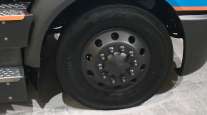The Low-Rolling-Resistance Trade-Off

The technology behind low-rolling-resistance tires is based on the benefit of reducing the resistance that’s caused by tires rolling on the surface of a roadway. Reducing this resistance means that the truck requires less energy and fuel, and as a result, runs more efficiently, industry experts said.
But a trade-off to the fuel savings that are so appealing to fleets is that LRR tires’ life cycle may be lowered. For now, tire manufacturers are riding on the benefit of the technology, while fleet operators are analyzing the trade-off and implementing their use of LRR tires carefully.
The fuel economy of LRR tires can be significant, according to Sanjay Nayakwadi, director of product strategy for Bridgestone Americas Tire Operations.

Michelin's X One Line Energy T is a low-rolling resistance and SmartWay-certified tire. (John Sommers II for Transport Topics)
“On a typical 6x4 tractor-trailer combination with 18 tires, we estimate that tires contribute 30% to 33% of the truck’s total fuel economy,” said Nayakwadi. “Broken down further, dual drive tires contribute around 45% of total tire rolling resistance, eight dual trailer tires will contribute around 40%, and two steer tires will contribute 15%.”
“So, there is no question that low-rolling resistance tires can play a significant role in reducing truck fuel consumption, and fleets are willing to pay a premium for these products,” Nayakwadi said.
While truck fleet operators see the benefit of LRR tires, they’re quick to point out the trade-off between fuel savings and the tires’ shorter material life cycle.
“These tires will run fewer miles because they have less tread to start with,” said Christoph Seitz, CEO of CFR Rinkens, an auto transporter in Paramount, Calif. “It’s likely you’ll get the same mileage per 32nd-of-an-inch of a comparable tire; but since you’re starting with less tread, they will end up taking you a shorter distance.”
LRR tires “are basically a compromise between traction, tread life and a tread pattern that rolls easier than other tires,” Seitz said.
The U.S. Environmental Protection Agency, meanwhile, views LRR tires as inclusive to SmartWay, its program to advance sustainable supply chains. These tires also are playing a role to help implement the agency’s Phase 2 greenhouse-gas emissions regulations.
LRR tires are one method manufacturers can use to help meet those tighter efficiency standards.
Phase 2 of the emissions requirements “has increasingly stringent targets from 2021 to 2024 to 2027, including rolling resistance values for tires,” said Sharon Cowart, product marketing director for Michelin Americas Truck Tires. “Original equipment manufacturers will certainly encourage the tire industry to continuously drive down tire-rolling resistance in order for vehicles to meet emissions targets.”
However, before the emissions standards and SmartWay targets, Michelin was “focused heavily” on developing truck tires with low-rolling resistance for customers who value fuel economy, she said.

A Bridgestone Escopia low-rolling-resistance tire. (Bridgestone)
Mahesh Kavaturu, marketing manager at Goodyear, pointed out that the EPA’s SmartWay program has been part of the North American trucking landscape for a long time.
“In the short term, longhaul fleets will continue to spec truck tires that have earned SmartWay verification,” he said. “Longer term, we believe that GHG Phase 2 requirements will drive greater demand for tires that go beyond basic SmartWay verification.”
“We call these products ‘super fuel’ tires,” Kavaturu said. “Fleets also will demand fuel-efficient retreads to meet increasingly stringent fuel-economy requirements.”
Manuel Vinas, product manager at Ryder Fleet Management Solutions, said that after fuel, “tires are the highest nonsalary cost for most fleets. It is important to weigh the total cost against the total savings that fuel-efficient tires can produce.”
“If not managed properly, using fuel-efficient tires potentially exposes a fleet to more breakdowns, shorter replacement cycles, increased downtime and higher tire costs,” Vinas said.
In addition, “as the fuel-efficient tread wears down, most of the benefit comes from the casing, which has to be properly utilized in order to gain from its extended life,” Vinas said. “Although there are many factors affecting fuel efficiency, if those factors are controlled, fuel-efficient tires can provide 6% to 14% better fuel economy, from worst to best case.”
Shane Nelson is the maintenance coordinator for the Cookeville, Tenn.-based Averitt Express. He sees LRR tires as beneficial, but also pays special attention to the trade-offs in using them.
“The acquisition of low-rolling-resistance tires will increase the total cost of a unit,” Nelson said. “While the percentage of fuel economy gained will eventually equal out, it takes several months and is difficult to monitor due to the small percentage of gain.”
Averitt Express ranks No. 32 on the Transport Topics Top 100 list of for-hire carriers in North America.
Ryder’s Vinas noted that LRR tires require a different compound to be used in the manufacturing of the tire, leading to premature wear.
“It can cause the tire to wear out faster and break down more often if not used in the right applications or with the proper air pressure,” he said. “They are most appropriate for linehaul fleets, where they are likely to have a longer life cycle that can yield the full benefits of the investment.”
To maximize the returns on fuel-efficient tires, “it is a good idea to use fuel-efficient retreads throughout the life of the casing,” Vinas said. Local pick-up and delivery fleets that operate in “a high-scrub environment typically will not see their fuel savings outweigh the cost of fuel-efficient tires before they have to replace them.”
Bridgestone’s Nayakwadi said that proper usage and care “play an important role in determining a tire’s ultimate longevity.”
Another way of extending the life of a tire is retreading, Nayakwadi said. “Premium-tire casings can be retreaded several times, which lowers tire costs over time and helps fleets fully maximize their tire-asset potential,” Nayakwadi said.
For example, fleets can start incorporating fuel-efficient tires into their tire program by outfitting the steer position with fuel-efficient premium new tires, he said. Then, they can retread the casing with a premium fuel-efficient retread at the drive or trailer position.
Michelin’s Cowart said the performance that fleets require should be balanced with rolling resistance.
“There needs to be a consideration of the operating environment and an understanding of how the tire can contribute to the success of the fleet,” she said. “The tire’s performance must sync with the nature of their operations, to their drivers and their habits, driving locations, maintenance habits, budget and other priorities, such as fuel costs. To that end, the best cost per mile or best cost of ownership will dictate what to select. Customers should work with the tire manufacturer and/or dealer to make the selection based on their needs and budget.”

Goodyear's Tire Optix technology can measure tread depth and tire pressure with a Bluetooth-enabled digital tool. (Goodyear)
She also noted that trailer tires account for approximately 42% of the vehicle’s tire-rolling resistance contribution by axle, according to the EPA’s GHG model. This makes it a prime wheel position for LRR tires, she said.
Trailer tires are typically ribbed tread designs that are lower in tread depth, which positively contributes to lower rolling resistance in this free-rolling position. The new regulations are contributing to the demand for LRR tires, Cowart said, noting they are “the fastest growing segment and accordingly, the number of offers is growing as well.”
The consensus of fleet operators that Equipment & Maintenance Update spoke to agree that LRR tires are welcomed equipment for today’s Class 8 trucks, especially in a regulated environment that requires fleet operators to be more fuel efficient and compliant with new standards. Tire manufacturers stand to benefit from this trend. Fleets probably will, too.
But as Kavaturu puts it, it always depends on the situation, the roadway, the severity of service and other factors.
“There’s no ‘one-size-fits-all’ formula when it comes to estimating the return on a driver’s or fleet’s tire investment since vehicle applications, individual driving styles, maintenance practices, driving surfaces and other factors can vary so widely,” Kavaturu said.




